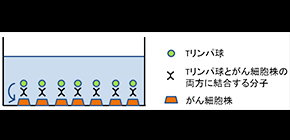
Treatment to a T? Taking a BiTE Out of Lung Cancer
Researchers at Osaka University reveal a correlation between the activity of T cells in lung cancer tumors and equivalent activity in the blood
Immune cells called T cells are key components in the fight against cancer when it arises in the body. However, they sometimes struggle to recognize cancerous cells or to launch an appropriate response against them. T cell activities can be tweaked to improve their anticancer effects using cancer immunotherapy, but this is only effective for a subset of patients, who are difficult to identify in advance.
In a new study reported in the journal Scientific Reports , researchers at Osaka University and colleagues have revealed a correlation between the cancer cell-killing activity of T cells within tumors in lung cancer patients and this same activity in T cells located far away in the blood in these same patients. They have also shown that this level of activity in the blood correlates with the effectiveness of a commonly used medication in cancer immunotherapy. This work provides a simple means of identifying which patients would benefit from cancer immunotherapy, potentially improving the outcomes of treatment for lung cancer.
The team used an approach called bispecific T cell engager technology (BiTE), which ensures that T cells encounter cancer cells, to assess the intensity of cancer cell killing by these immune cells. They compared this cell killing activity of T cells from lung cancer tumors, healthy lung tissue, and peripheral blood. They also investigated the correlations of such activity with factors such as whether the patient was a smoker, the presence of certain gene mutations, and the levels of immunity-related molecules called cytokines.
“After optimizing the BiTE conditions for assaying T cell cytotoxicity, we characterized the T cells from the three sample sets and looked at their correlations with other clinical and lifestyle-related factors,” Atsushi Kumanogoh says. “We first found that T cells were more cytotoxic in smokers and that high T cell cytotoxicity within tumors was linked to the expression of some cytokines.”
The team then found that, within individual patients, the cytotoxicity of T cells in the blood was actually the factor that most strongly predicted the cytotoxicity of T cells within lung tumors. It also reflected the effectiveness of the immune checkpoint inhibitor nivolumab at destroying tumor cells. This inhibitor is an antibody that targets and blocks the activity of the molecule PD-1 in suppressing the immune system.
“The ability to diagnose cases using just blood samples would mean that patients won’t have to undergo invasive procedures such as biopsy for tumors in the lungs,” lead author Kota Iwahori says. “We could then evaluate whether the use of cancer immunotherapy would be appropriate for a particular patient, hopefully improving the outcomes in lung cancer patients.”

Figure: Method for measuring T-lymphocyte activity
The team measured the T-lymphocyte cytotoxicity against tumor cell lines using a molecule that binds to both T lymphocytes and tumor cell lines.
(credit: Osaka University)
The article “Peripheral T cell cytotoxicity predicts T cell function in the tumor microenvironment” is published in Scientific Reports at DOI: https://doi.org/10.1038/s41598-019-39345-5 .
Related links
